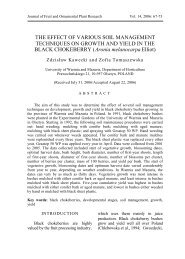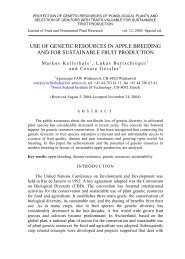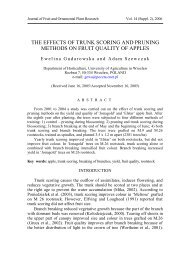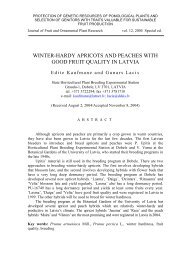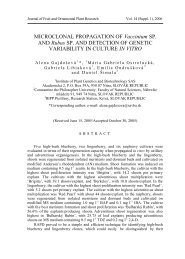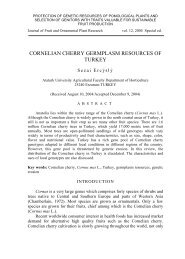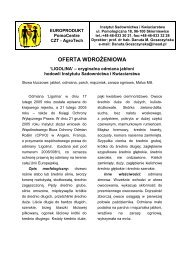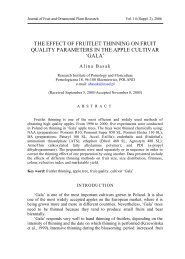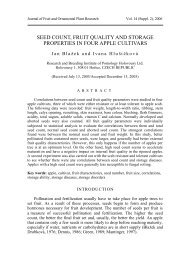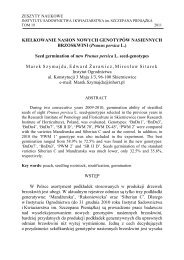HORMONAL CONTROL OF GUMMOSIS IN Rosaceae
HORMONAL CONTROL OF GUMMOSIS IN Rosaceae
HORMONAL CONTROL OF GUMMOSIS IN Rosaceae
Create successful ePaper yourself
Turn your PDF publications into a flip-book with our unique Google optimized e-Paper software.
M. Saniewski et al.Jasmonates promote gum production in tulip bulbs and stone-fruit treesand their fruits (Saniewski et al., 2000). JA-Me induced gum formation inplum shoots and fruits, peach shoots, cherry shoots and apricot shoots(Saniewski et al., 1998; 2003a; 2004ab). Endogenous jasmonates rapidlyincrease in plant tissues in response to infection, insect attack, mechanicaldamage, osmotic stress and other abiotic stressors (Saniewski, 1997). Stressinduces ethylene production in plants. Jasmonates increase ethylenebiosynthesis in intact plants and their organs by stimulating ACC synthaseand ACC oxidase activity (Saniewski, 1995; 1997; Saniewski et al., 1995).Exogenously applied JA-Me substantially increases ethylene production inpre-climacteric apples and in tomatoes at different stages of ripening(Saniewski, 1995).How jasmonates control ethylene biosynthesis in stressed tissues is not yetfully understood. In the plants described above, JA-Me seems work by thesame mechanism as ethephon (Saniewski et al., 2004ab).Interaction of ethylene and jasmonates in induction of gummosisApplying JA-Me and ethephon at the same time enhances gum productionin cherry, plum, apricot and peach shoots far more than applying either JA-Meor ethephon alone. Endogenous jasmonates and exogenously applied ethyleneact synergistically in gum formation. The reverse situation is also possible.The level of endogenous ethylene may be high enough to induce gumformation with exogenously applied JA-Me. Another possibility is thatethylene was able to induce gum formation without an increase in ethyleneconcentration because the process had already been triggered by JA-Me.When ethylene binds to its receptor on the plasma membrane, it might sensitizeJA-Me membrane receptors (Xu et al., 1994). In this case, ethylene and JA-Me mayco-regulate osmotin gene expression. JA-Me and ethylene synergistically causedthe breakdown of cell membranes and cell disintegration (Emery and Reid, 1996).This might be the reason for the induction of gum formation. Ethylene interactswith jasmonates in gummosis and other physiological processes (Saniewski et al.,1999). When JA-Me alone is applied ornamental Japanese cherry shoots, it does notinduce gum formation. This is probably because the level of endogenous ethylene istoo low to induce gummosis (Ueda et al., 2003). When inhibitors of cell wallpolysaccharides biosynthesis such as monensin and 2,6-dichlorobenzonitrile areapplied together with ethephon or JA-Me, they do not inhibit gum production(Saniewski et al., 2004b). Gummosis is therefore probably independent of the sugarmetabolism involved in the biosynthesis of cell wall polysaccharides. Whenethephon is applied together with inhibitors of jasmonates biosynthesis such asdiethyldithiocarbamate, salicylic acid, acetylsalicylic acid, indomethacin, ibuprofen,phenidone, or monophenylbutazone, it inhibits gum production in plum fruits.On the other hand, when inhibitors of ethylene biosynthesis such assalicylic acid, acetylsalicylic acid, aminooxyacetic acid and CoCl 2 are appliedtogether with JA-Me, they do not limit gum formation. This is difficult to140J. Fruit Ornam. Plant Res. vol. 14 (Suppl. 1), 2006: 137-144



